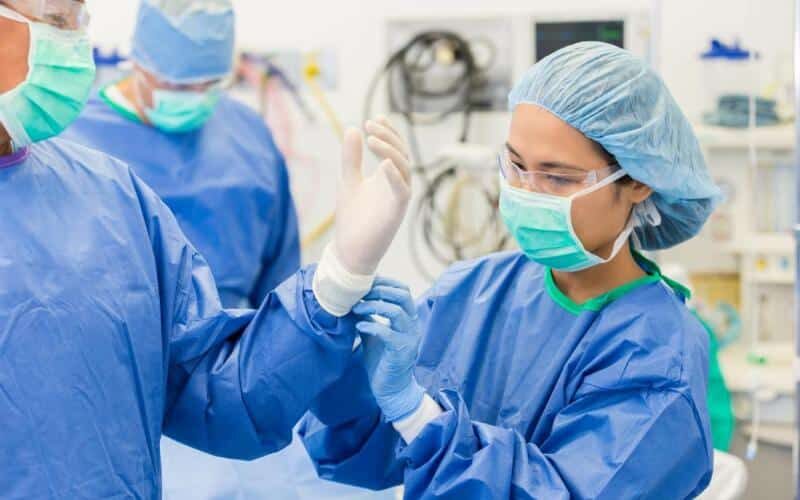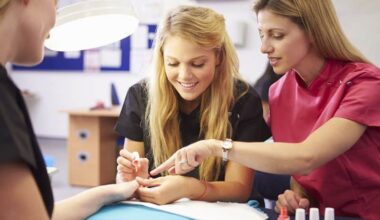Table of Contents
Please take a good look at your hands and tell me what you can see, I can bet that with a decent microscope, you will see a lot of germs. Even the entire surface anatomy of oneself literally has germs all over it which mandates every person to try to keep himself or herself clean at all cost.
This is all seeming very hilarious and strange but it brings us to a common enemy about the field of medicine and medical research, “GERM”. Surgical Asepsis will tell us more as related to the medical field as a whole.
With all stated above, we can rest assured say It has become a question in the Medical world on the entire makeup of Surgical Asepsis and what it entails as a whole. Is it a term? A practice? Or the big question,” a career line?”.
Well, this article is readily assembled by our group of medical researchers to lay out the concrete foundational knowledge on what Surgical Asepsis is all about i.e Its definition and benefits. Along the way, one could also gain a clear picture of its relationship with Medical Asepsis.
What is Surgical Asepsis?
Surgical Asepsis by definition is the absence of all microorganisms within any type of Invasive procedure. In other words, it’s a sterile technique wherein there is a removal of microorganisms before they can enter an open surgical wound OR contaminate a sterile field.
On the other hand, a medical Asepsis simply is a state of being free from disease-causing microorganisms which brings clarity as to the fact that surgical asepsis involves sterilization of medical equipment to avoid infection while medical Asepsis involves keeping away disease-causing organisms from the body of an individual. (medical asepsis vs surgical asepsis)
Component of Surgical Asepsis
Necessary components of surgical asepsis include :
- Knowing what to sterile.
- Knowing what isn’t sterile.
- How to keep the first two conditions separate.
- How to remedy contamination immediately.
#1. Knowing What To Sterile
Before any use on a patient, sterilize critical medical and surgical devices or instruments that enter normally into the sterile tissue or vascular system or through which a sterile body fluid flows. e.g. BLOOD.
Provide, at a minimum, high-level disinfection for semi-critical patient-care equipment s e.g. Gastrointestinal endoscopes, Endotracheal tubes, anaesthesia breathing circuits and respiratory therapy equipment that touches either mucous membrane or non-intact skins
Perform low-level disinfection for non-critical patient-care surfaces (e.g. bed-rails, over-the-bed-table) and equipment s (e.g. blood pressure cuff) that touch intact skin.
#2. Knowing What Isn’t Sterile
The term “non-sterile” in medicine can refer to any items that do not meet the sterility assurance level (SAL) established by a region. The SAL basically implies that all items judged sterile have been cleaned and packaged to their standards. Without this guarantee, items can be judged contaminated.
#3. Keeping The First Two Conditions Seperate
This is logical as to the fact that a sterile field should be treated separately promptly after there has been a clear identification between a Sterile and non-sterile field. Moreover, the management of these two fields is completely on different scales.
Principles of sterile techniques
All personnel involved in an aseptic procedure are required to follow the principles and practices set forth by the Association of Operative Registered Nurses (AORN). These principles must be strictly applied when performing any aseptic procedures, when assisting with aseptic procedures, and when intervening when the principles of surgical asepsis are breached.
It is the responsibility of all health care workers to speak up and protect all patients from infection.
Saftey Precaution Necessary
- Hand hygiene is a priority before any aseptic procedure.
- When performing a procedure, ensure the patient understands how to prevent contamination of equipment and knows to refrain from sudden movements or touching, laughing, sneezing, or talking over the sterile field.
- Choose appropriate PPE to decrease the transmission of microorganisms from patients to health care worker.
- Review hospital procedures and requirements for sterile technique prior to initiating any invasive procedure.
- Health care providers who are ill should avoid invasive procedures or, if they can’t avoid them, should double mask.
These are the techniques/ Principle guiding any Sterile process:
#1. All objects used in a sterile field must be sterile
Commercially packaged sterile supplies are marked as sterile; another packaging will be identified as sterile according to agency policy. Check packages for sterility by assessing precision, dryness, and expiry date before use.
Any torn, previously opened, or wet packaging, or packaging that has been dropped on the floor, is considered non-sterile and may not be used in the sterile field.
#2. A sterile object becomes non-sterile when touched by a non-sterile object
Sterile objects must only be touched by sterile equipment or sterile gloves. Whenever the sterility of an object is questionable, consider it non-sterile.
Fluid flows in the direction of gravity. Keep the tips of forceps down during a sterile procedure to prevent fluid from traveling over the entire forceps and potentially contaminating the sterile field.
#3. Sterile items that are below the waist level, or items held below waist level, are considered to be non-sterile
Keep all sterile equipment and sterile gloves above waist level. Table drapes are only sterile at waist level.
#4. Sterile fields must always be kept in sight to be considered sterile
Sterile fields must always be kept in sight throughout the entire sterile procedure. Never turn your back on the sterile field as sterility cannot be guaranteed.
#5. When opening sterile equipment and adding supplies to a sterile field, take care to avoid contamination.
Set up sterile trays as close to the time of use as possible, Stay organized and complete procedures as soon as possible, Place large items on the sterile field using sterile gloves or sterile transfer forceps. Sterile objects can become non-sterile by prolonged exposure to airborne microorganisms.
#6. Once a sterile field is set up, the border of one inch at the edge of the sterile drape is considered non-sterile.
Place all objects inside the sterile field and away from the one-inch border.
#7. If there is any doubt about the sterility of an object, it is considered non-sterile.
Known sterility must be maintained throughout any procedure.
#8. Sterile persons or sterile objects may only contact sterile areas; non-sterile persons or items contact only non-sterile areas.
The front of the sterile gown is sterile between the shoulders and the waist, and from the sleeves to two inches below the elbow. Non-sterile items should not cross over the sterile field. For example; a non-sterile person should not reach over a sterile field.
When opening sterile equipment, follow best practices for adding supplies to a sterile field to avoid contamination. Placing non-sterile items in the sterile field is not permitted.
#10. Movement around and in the sterile field must not compromise or contaminate the sterile field.
Do not sneeze, cough, laugh, or talk over the sterile field, Maintain a safe space or margin of safety between sterile and non-sterile objects and areas, Refrain from reaching over the sterile field ( a necessary factor).
Keep operating room (OR) traffic to a minimum, keep doors closed and Keep hair tied back. When pouring sterile solutions, only the lip and inner cap of the pouring container is considered sterile. The pouring container must not touch any part of the sterile field. Avoid splashes.
What are the impacts of Surgical Asepsis?
The skin is the first line of defense for the human body against germs which implies that an individual is vulnerable to infection if there’s a break in the skin of the person whether it be by accident or Surgical Incision.
Aseptic techniques help prevent healthcare-associated Infections (HCAIs). HCAIs is an infection that an individual obtains as a result of treatment from a healthcare professional due to unsterilized equipment.
Several HCAIs occur which are listed below:
- Catheter associated urinary tract infection.
- Central line associated bloodstream infection.
- Clostridium difficile Infection.
- Surgical site infection.
- Ventilator associated pneumonia.
These infections are very crucial to take into consideration as they can lead to severe health complications for the patient and a thorough penalty for the healthcare facility.
READ ALSO: Orthodontist Assistant | What it is, How to Become One, Duties, Training, Salary and More.
Who performs surgical Asepsis
Aseptic practitioners are simply the healthcare professionals that work in the healthcare surgical laboratory e.g. the Nurses, Doctors/Surgeons as well as medical lab assistants.
How Much Does Surgical Aseptic Practitioner Earn?
When we come into the Salary of healthcare professionals, One could clearly come to the fact of them being one of the highest-paid labor groups in many countries across the globe.
Such individuals have secure medical insurance for themselves and their families, highly paid ranging between (5000-12000)$ monthly in America, about 7000£ in Britain e.t.c.
You can check the link below to see how much you can really earn in detail as a surgical aseptic practitioner
Fieldwork Needing Surgical Asepsis Professionals
These healthcare professionals can function in many places in general, Some is hospital-based, dealing with the affairs of the injured, disabled and diseased. Many others find themselves in firms, industries, brokerages, banks and many other places to render medical attention when needed within these private sectors.
Moreover, they are also employed by the government in the government houses, armed forces and other governmental institutions for the rendering of medical assistance to the higher authorities.
Conclusion
Coming to a settled understanding of the ins and outs of surgical asepsis, the article is set to aim for individuals’ understanding of the subject matter and to pave a path for those that have a dream to pursue this field as a career path.
If any questions, contact us via our email; [email protected] and if clarified, please be free to share and comment.
FAQs
What is the difference between medical asepsis and surgical asepsis?
A medical Asepsis simply is a state of being free from disease-causing microorganisms which brings clarity as to the fact that surgical asepsis involves sterilization of medical equipment to avoid infection while medical Asepsis involves keeping away disease-causing organisms from the body of an individual.
What is the most accurate definition of surgical asepsis?
Surgical Asepsis by definition is the absence of all microorganisms within any type of Invasive procedure.
What are 4 examples of medical asepsis?
They include hand washing, bathing, cleaning environment, gloving, gowning, wearing mask, hair and shoe covers, disinfecting articles and use of antiseptics.
Why is surgical asepsis important?
Why Aseptic Technique Is Important is because t’s designed to keep dangerous bacteria and other microorganisms out of wounds and protect you from infections when you’re recovering.
What is aseptic technique used for?
* Handling surgery equipment.
* Helping with a baby’s birth by vaginal delivery.
* Handling dialysis catheters.
* Performing dialysis.
* Inserting a chest tube.
* Inserting a urinary catheter.
* Inserting central intravenous (IV) or arterial lines.
* Inserting other draining devices.
Publisher Recommendation
- How to Become an Ultrasonographer | What They Do, Education Requirements, Certificates & Salary
- Pharmacology Degree | How to Become a pharmacologist.
- How To Become A Mental Health Clinician | What They Do, Requirements, Training, Certificates & Salary.
- How Much Do Substitute Teachers Make In California?
- Orthodontist Assistant | What it is, How to Become One, Duties, Training, Salary and More.
- Interior Design Degree | A Right Program For You To Study In Germany.
- EKG Technician | How to Become One, Job Description, Salary, Skills & More.
- Environmental Technician | How To Become One, Job Description, Salary, Skills & More.
- Human Resources Assistant | What They Do, Salary, Required Skills and More.
- IT Project Manager | How To Become One, Job Description And What You Will Need To Get Started.
- Nail Technician Schools and Colleges in the U.S. | Top 9 Best.






